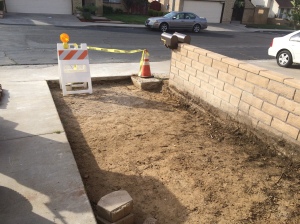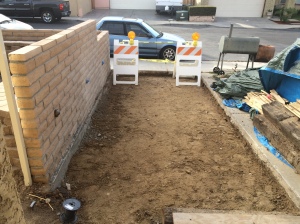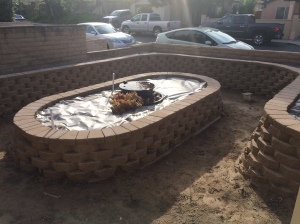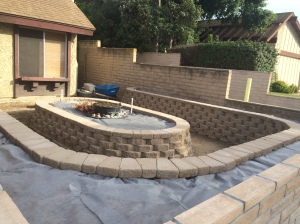Now that the wall framing was up, it was time to start installing everything that goes inside the framing. That means electrical and plumbing lines, and in my case, data cables and fire sprinkler piping. In this entry, I’ll briefly address the rough electrical, plumbing, and data lines, as I will have a separate entry on the sprinkler system (because it’s unique and cool).
Rough service work begins with locating where you want to put stuff. For plumbing, that’s usually spelled out in the plans, e.g., where you want the sink, shower, and toilet, so that part is pretty easy, and the relevant dimensions of where the plumbing fixtures connect are standardized. However, there are some nuances that must be considered, and since I’m doing an entirely custom installation, I decided to get all of my fixtures up front. That way (a) I could look at the installation instructions and actually do measurements if I needed to, and (b) the fixtures all matched. It cost quite a bit up front, but at least that expense is taken care of (!). So, I went ahead and marked where I wanted the toilet, sink, and shower drains and water supplies to go. Now, I had to learn plumbing.

All fixtures and parts for the bathrooms, plus the toilet and sink for the MBR bathroom.

The rest of the parts for the bathrooms. I also bought all of the tile at once to make sure I had it from the same run. Lots of stuff to warehouse!
As a chemical engineer and as an engineer on a nuclear sub, I figured I could deal with the technical aspects of a residential plumbing job. I had to review the relevant codes to make sure I was in compliance, but then I figured, how hard can this be? I was about to find out….
I decided to start with the toilet drain because it was the largest pipe and I found out I would have to be doing some tricky routing through the joists, which I had previously tripled to shore up the master bedroom floor structure. These extra thick joists turned out be be troublesome because the pipe had to be angled to get the slope correct and the hole saw that I was using was only slightly larger than the OD of the pipe. I eventually hammered it in but getting that last joint together was a bitch! I hope it doesn’t leak.

Toilet drain piping. See the tripled joists surrounding the pipe? I had to drill big holes through those and ram the piping in!
The next challenge was putting together the water supply system for the showers. I decided to ramp up the quality of the showers by installing a “smart” shower system that uses an electronic control in the shower to remotely control the mixing valve. I went with copper pipe because that’s what the house had to begin with, and I sure got some good experience in sweating the pipes together (turns out that it’s not that hard). The best advice that I got was to use MAPP gas instead of propane. The higher temperature of the flame makes the solder flow much better. Nevertheless, It’s a complex setup and I ended up gouging one of the press-fit O-rings when I inserted the pipe into the mixing valve, so it caused a bit of a mess when I turned on the water to pressure test.

Diagram of the remote shower mixing valves. These are located in the garage directly below the bathrooms. The hot and cold water supplies connect to the mixing valves and the remote controller sets the temperature and volume through the controller signal lines. The water then goes directly to the shower head(s).

Remote shower controller. This is all electronic and has a memory for 4 different settings (his/hers/morning/after workout/whatever).
I also found some cool water supply valves that were recessed into the wall and had a very clean look. They are called “stop pull boxes” and are made by a company called “LSP”. If you’re interested, here is their website: LSP Pull Stop Box
And some pictures:

Recessed water supply valve. The valve is the brass fitting in the middle. If you look closely, you can see the ball valve itself (the silver thing in the middle). This is really slick because it’s behind the drywall and the valve is operated by a pushrod attached to the threaded rod on the left-hand side. Looks very clean after installation which I thought was important for a pedestal sink.

Recessed valve installed. The eustachon will cover the hole OK. The brand is “LSP” and the device is called a “pull stop box”.
Going on to rough in the electrical, the plans are important, but I decided I wanted to do some Human Factor Engineering to get the exact location of the switches and lighting fixtures. I imagined myself doing everyday tasks like going to the bathroom, going to the shower, getting dressed, getting ready for bed, etc., and that helped me locate switches so that (a) they would be easy and intuitive to reach for and (b) I could operate the lights from different locations to minimize going back and forth when I wanted to turn something on or off. I also put in extra wall receptacle boxes, especially near where the bed and home office would be. Receptacle and switch boxes are pretty easy to install, so with that done, I was ready to start running wires.

Example of the customization that one can do if you’re doing this yourself. I added the data and power boxes for the flat screen TV at the last minute (at no cost to the customer).
Running the wires for the rough electrical is something that’s not typically in the plans, which only show the locations of the receptacles, switches, and fixtures. I guess I could have done a schematic diagram, but I figured I would only be doing this once, and as long as I was disciplined in labeling each wire, I would be OK. To run the wires, I did have to plan out where I would be bringing in power from the electrical panel, and then how that power would be distributed throughout the room. The bedroom has two circuits: one for the sink in the bathroom, which needs to be a dedicated GFCI circuit per code, and one for the receptacles and lights. The “current” electrical codes (pardon the pun) require that receptacles in living spaces (bedrooms, living rooms, dens, dining rooms) be AFCI protected, so I needed to take that into account as well. The dedicated GFCI circuit was pretty easy (one wire from the panel to the receptacle), but the other wiring was more involved. The first thing that I did was to bring in power to a receptacle box, and then distribute power to the other receptacle boxes from there. The lighting circuits then tapped off the receptacle boxes.
One thing to keep in mind is the number of wires you have running in and out of each box, and the number of “devices” (switches, receptacles, both of which are referred to as “yolks” in the trade). There is a limit based on the heat load, and there’s a fancy calculation in the NEC, which it turns out, is not trivial. Here is a link to an good explanation. To make things a little easier, I just always get the biggest box possible for the number of devices I want (switches/receptacles) and have not run into any problems.

Good example of tailoring the electrical controls beyond the minimum. I can control both lights outside the garage (front and side) and the garage work lights from this location. The front garage door light can also be controlled from the master bedroom and the front door because it is a security and safety feature. I’ve also installed smart switches, where necessary, to allow control automatically under given conditions (e.g., coming home at night, opening the garage door, fire alarm or smoke detector goes off to illuminate egress routes). The receptacles with built-in USB chargers are a must, pretty much in every room.
Routing the wire takes a little planning. The main idea is to drill as few holes as possible, which typically results in running the wires in the ceiling. The other “trick” is to unroll the wire so that it’s flat. If you just pull the wire from the roll, then it will come out twisted and be difficult to staple neatly to the framing. Unrolling it before you pull the wire takes some effort: you have to pick up this heavy roll and heave it ’round several times. But it pays off with a neat and professional installation.
After the wiring was installed, I needed to energize some circuits so we could continue to live normally (if you call living in a house during a remodel “normal” — I guess it’s the “new normal” for us). Despite my supreme confidence in my ability to install some relatively simple electrical work, I flipped on one of the breakers and there was a loud “pop” (“arcing and sparking” in the trade).

I thought I smelled something funny. Better find out what happened here!
Turns out that I tightened down the cable clamp too tightly and the clamp cut through the insulation and caused a short.

Forensic analysis showed that I had tightened down the strain relief so much that it cut through the insulation and caused a short. More is not necessarily better!
I felt pretty bad and embarrassed about that, but later, after doing some additional reading in my electrical “how to” books, I found that these sort of things occasionally happen even for the pros. I guess that’s one way to get experience! At any rate, I had to pull the entire cable and replace it because you’re not allowed to splice or patch an electrical cable. All interconnections must be in electrical boxes that have an opening through the drywall to prevent an electrical short from causing a fire behind the drywall.
Lastly is the data cabling. For my project, I’m running a minimum of 2 cat6e ethernet cables and one RG-6 cable per room, but the the master bedroom and home office, I ran quite a few more. I started with standard electrical boxes, but found that low voltage boxes are easier to work with, so from now on, I’m using those. Because these cables are circular in cross section, there’s no need to be too fussy with the unrolling. However, the installation should still be neat. I found some nice cable organizers that allowed me to create nice data cable runs, which was important as the cabling multiplied as I approached the wiring closet.

Data cables running through the attic. With a minimum of 2 Ethernet and one coax cable per room, that added up pretty quickly. I put a lot of these in the master bedroom because I wanted the cables for a flat screen TV and a home office.

Wiring closet replaces the furnace, which was relocated to the attic. All data cabling from the upstairs is run and neatly bundled (on the right). The loose stuff is the cabling from the living room and garage, which needs to be bundled later when I run the rest of the downstairs cabling.
Finally, I had to install draft stops. The inspector pointed this out to me, so that was something I was unaware of, but once I figured it out, it was pretty easy. Basically, wherever you have a penetration through the sole or top plates of your framing, you need to seal the openings. The best way is to use polyurethane foam that comes in a can. You can get a one-use can with an applicator, but I found that hard to control, so I ponied up for a pro applicator, Worked much better, and I figured I’d be using it for other things.

Draft stop for the data lines coming into the wiring closet. I also had to accommodate the gas line going up to the furnace, which is now in the attic.
So with the rough work done, it was time to put in one of the true infrastructure “upgrades” that I planned for this remodel: a residential fire sprinkler system. Stay tuned…..
















































































